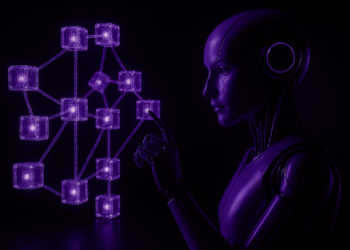As more and more organisations embrace digital, remote working and cloud-based technologies, the levels of risk to which they are exposed are increasing.
Indeed, every year, more and more organisations are in the firing line of cyberattacks. And these attacks are costing more and more for the companies that fall victim to them. In 2021, the average cost of a data breach was $4.24 million. This average has increased considerably as a result of the global pandemic, which has led to a sharp increase in teleworking.
However, these cyberattacks are not inevitable. Many solutions exist to anticipate, prevent and neutralise them.
So what do we mean when we start talking about cybersecurity? What is a cyberattack? Why is it essential for companies to secure their digital environment? What is the link between cybersecurity and digital transformation?
That’s what we’re going to find out in this article with the help of our cybersecurity experts.
1. What cybersecurity challenges does your company face?
What is cybersecurity?
Cybersecurity is the set of tools and methods that make it possible to wage war, at different levels, against cybersecurity threats. These digital threats can target hardware, software and data.
Your computer network continuously circulates a lot of information that you need to protect. Cybersecurity makes it possible to ensure the protection and integrity of this data. As a result, one aspect of cybersecurity is to maintain the confidentiality, integrity and availability of your company’s data.
The term ‘cybersecurity’ is very general and can be broken down into various, more specific, sub-categories. Indeed, an effective approach to cybersecurity involves several layers of protection. This includes technologies, processes and users (in the case of a company, this means all your employees).
- The technologies
Here, three main levels can be identified: tools (such as all connected computers and devices, routers); networks, and the cloud.
- The process
Organisations need a clear framework to prevent and manage cyberattacks. This framework explains how to properly identify attacks, protect systems, detect new threats and respond to them. A series of protocols must be ready to be implemented when a cyberattack is launched or a threat is detected. The aim is to minimise any possible damage and to ensure the integrity and confidentiality of the information.
- The users
Users – your employees – need to understand and respect some basic rules, such as using strong passwords, exercising caution around email attachments, and having good data-backup habits.
It’s a question of both protecting and also training your teams about the risks. This is a very important step when you consider that employees are the entrance point for 35% of cyber attacks.
What is a ‘cyberattack’?
A cyberattack is a malicious and deliberate attempt to penetrate the information system of an individual or organisation.
These attacks are designed to exploit vulnerabilities in the system in question to disrupt, disable, destroy or control data or the company itself. The aim of a cyberattack is usually to steal data, make operational tools unavailable, and extort large sums of money.
These cyberattacks take different forms to better thwart any protective measures companies have taken. The most common threats are malware, phishing, and ransomware.
- Malware and ransomware
These malicious programs enter a network through a loophole, usually when a user clicks on a dangerous link or attachment. Once inside the system, this malware can either block access to data by encrypting it (known as ransomware) or install malware or other dangerous software.
- Phishing
Phishing is one of the most well-known types of cyberattack. Phishing is the practice of sending fraudulent communications, usually by email. The aim is to steal sensitive data such as credit card and login information, or to install malware on the victim’s device.
What would the consequences of a cyberattack be for your organisation?
According to Cybercrime Magazine, one in six companies that fell prey to cybercrime in 2020 say they were at close risk of bankruptcy. In addition to the cost of a possible ransom demand or loss of business due to the paralysis of computer systems, a company’s image and reputation are extremely weakened during a cyberattack.
2. What role does cybersecurity have in digital transformation?
A little reminder about digital transformation…
Computing, then the internet and, today, the cloud and artificial intelligence have profoundly impacted the way companies operate and serve their customers. Digital transformation is the integration of these new digital technologies into the activities of a company. Digital transformation therefore encourages an organisation to fully review its information system, and to organise and optimise it, both technically and in terms of processes. This is a real fundamental movement for companies, revolutionising business models and rethinking customer and employee relations through the use of digital technology.
Further reading: Digital transformation: what does it mean?
What is the link between cybersecurity and digital transformation?
With the digital transformation of businesses accelerating, and in response to new demands in the world of work and changing consumer behaviour, cybersecurity is becoming more and more essential for all companies and organisations.
To succeed in your digital transformation, you need to ensure that security is built into every step of this transformation, or risk becoming a victim of cyberattacks.
While digital transformation is different for every company, it generally involves a change, to a greater or lesser extent, in the way organisations operate and use technology. Digital technology is becoming increasingly important in all business operations. However, by changing the way components and employees interact with each other, digital transformation introduces new issues and therefore new risks. It also means that more and more data will be stored and circulated.
But sometimes, due to a lack of knowledge, many companies, in their rush to bring newer technologies and software online, overlook cybersecurity. This makes them highly vulnerable to attacks. In France, 8 out of 10 companies are affected by cyberattacks every year.
To support your digital transformation, protect your business and ensure the security of your data, your customers and your employees, it is essential to implement a cybersecurity strategy. Taking cybersecurity into account in a digital transformation right from the very beginning of the project, and during all subsequent design phases, allows you to ensure optimal security.
Digital transformation initiatives must therefore integrate cybersecurity as early as possible, from the strategic alignment stage onwards.
3. Cybersecurity with Wemanity Secure
Some cybersecurity advice: protect yourself against cyberattacks.
There are lots of tips to help you benefit from optimal security. It is important to regularly assess the reliability of the various elements that make up your information systems. Furthermore, taking an inventory to make sure you know all the devices and applications connected to your network will give you a real and comprehensive overview of your computer system. This will allow you, among other things, to ensure that your machines and anti-virus systems are up to date. In the event of an attack, you will be able to identify and close any vulnerabilities.
The assessment of WiFi security and the implementation of technical architectures to achieve security objectives at the CIAT level (Confidentiality, Integrity, Availability, Traceability) are equally necessary.
The human element is also very important in cybersecurity, especially with the increase in teleworking. You need to raise awareness and provide your staff with cybersecurity training so that they are aware of the risks.
Finally, it is essential to be supported in defining and implementing a security strategy for your information systems. Whether it is to analyse your security level, the potential incidents you might fall victim to, or to support you in the event of a cyberattack.
Cybersecurity support: how can risks be prevented?
Along with all of Wemanity’s other services, Wemanity Secure is the Wemanity label that integrates cybersecurity into every stage of your digital transformation, helping you to better understand your organisation’s maturity and the cybersecurity solutions available.
This ‘secure by design’ support enables you to design, implement and maintain cybersecurity programs. It is divided into three parts:
- We integrate Wemanity Secure’s expertise into our Wemanity services in order to think about security from the design phase of your digital transformation and at every stage of it in order to anticipate and deal with any risks that may arise.
- We provide support and advice to all companies, where the digital transformation is still at an early stage, in order to work on specific levers and optimise what we consider critical.
- We share our knowledge and expertise to ensure the training of your internal services by suggesting high potential resources, selected and evaluated by us.
We are convinced that optimal security can be achieved with simple adjustments, without disrupting the way employees work. We have the ability to adapt to everyone’s means, and believe that our customers should not have to choose between the development of their business and the security of their transactions and data.
As you will be able to see by now, cybersecurity is a major challenge for companies and simply must accompany your digital transformation. Cyberattacks, which have a very heavy impact on the health of companies and organisations, will multiply if your digital transformation does not integrate cybersecurity into its logic. The success and sustainability of digital transformation can only be guaranteed if security issues are integrated from the earliest design stages and throughout the project cycle. Organisation, roles, skills, human capital… Cybersecurity is everyone’s business! This is why, through our Wemanity Secure service, we make cybersecurity an integral part of your digital transformation.
Article written by Juliette Brun, with comments from Damien LEVEQUE – Chief Information Technology Officer @Wemanity Secure, Luiza Tendler – Co-Founder & CEO – @Wemanity Secure and Eric Ducasse – Transformation Office Leader @Wemanity.












